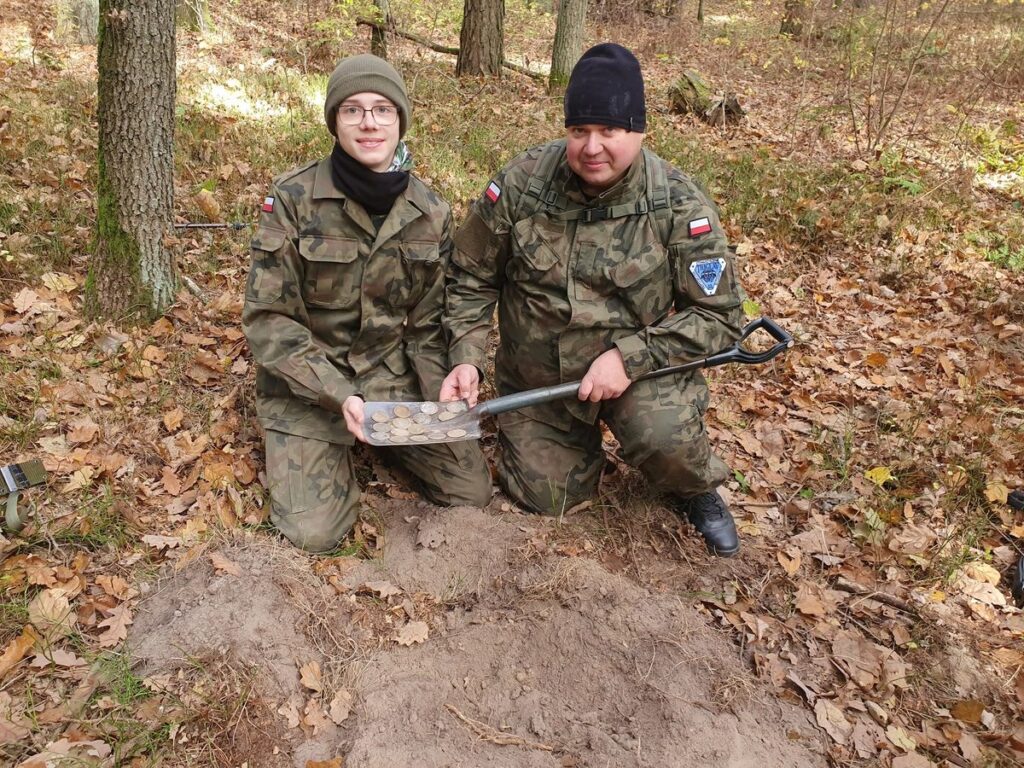Father-and-son duo Sławomir and Szymon Milewski discovered the coins while searching for a Roman road.
Polish “Husaria” Treasure Hunters Association
While wandering a Polish forest, a father-and-son duo has uncovered 17 rare historic coins. Found near the village of Pomiechówek, located north of Warsaw in the region of Mazovia, the cache is worth more than $120,000.
Earlier this month, metal detectorists with the Triglav Historical and Research Association and the Polish “Husaria” Treasure Hunters Association were searching for the remains of a Roman road.
The team never found the road, as a spokesperson for the latter group, which was leading the search, tells McClatchy’s Irene Wright. However, two treasure hunters—Sławomir Milewski and his son Szymon—stumbled upon something else.
The 17 coins date to the 16th and 17th centuries.
Polish “Husaria” Treasure Hunters Association
As Piotr Duda, an archaeologist with the Triglav Association, tells Science in Poland, the metal detectorists immediately recognized their findings as silver coins. Upon closer examination, they were stunned by the artifacts’ clear historical significance.
“At first, there was a great noise, because everyone who participated in the search—and there were a dozen of us—came running at the call of the discoverers,” Mateusz Sygacz of the Polish Treasure Hunters Association tells All That’s Interesting’s Kaleena Fraga. “We all realized that we had discovered something incredible.”
A 1604 silver coin
Polish “Husaria” Treasure Hunters Association
Dating to the 16th and 17th centuries, the collection includes two types of coins: thalers and patagons. Thalers are large silver coins used throughout Europe for centuries; the word “dollar” is derived from “thaler.” Meanwhile, the patagon is also a large silver coin, but it was minted in the Spanish Netherlands—provinces held by Spain, including modern-day Belgium, Luxembourg and the Netherlands.
Many of the coins are marked with the faces of European rulers. One is a 1630 thaler depicting Sigismund III Vasa, once the king of Poland and Sweden, complete with the initials of the coin maker, per a Facebook post from the Polish Treasure Hunters Association. Another, a 1623 thaler, was only minted for two years, making it a very rare find. Many of the coins were made during the Thirty Years’ War—a brutal period of conflict, famine and disease that ravaged Europe between 1618 and 1648.
According to another post from the association, the cache’s oldest coin was made between 1564 and 1587, while its newest dates to 1641. The finders wonder how such a varied collection ended up near Pomiechówek.
“We suspect that one of the soldiers lost his pay,” Sygacz tells All That’s Interesting. “Another assumption is that the burial was made by a merchant who wanted to hide his property from potential robbers—there was an inn about a kilometer away [during] the 16th century, and we know from earlier discoveries of similar deposits that it was a common practice to hide valuables before visiting an inn.”
The treasure hunters handed over their coin collection to the local official conservator of monuments. Officials are hoping the collection will then find a home in a museum.


